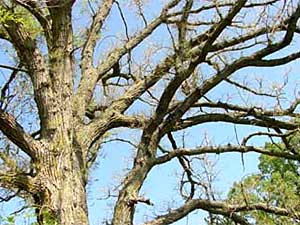January 21, 2005
 |
| Gypsy moths are marching across the eastern United States -- devastating trees and forests along the way. This tree has lost much of its foliage due to gypsy moths. (Photo by M. Guthmiller, courtesy of Wisconsin DNR) |
Duluth, Minn. — Gypsy moths have been pushing this way from the eastern part of the country for more than 100 years. Now the small brown moths could be establishing a foothold in northern Minnesota.
Northern residents routinely experience a similar pest, when forest tent caterpillar populations explode every seven years or so.
Similarly, it's not a pretty sight when hordes of hungry gypsy moth caterpillars eat their way through forests -- leaving nothing but empty branches, webs, and poop. Andy Schofs is with American Landscape and Tree Service in Menominee Falls, Wisconsin, and he's seen plenty of gypsy moths.
"I've seen in subdivisions, wooded subdivisions, where people's driveways are just totally brown with excrement from the droppings," Schofs says. "People say overnight if you listen outside, you can just hear crunching and chewing and things falling."
Gypsy moths are native to Europe. Some were brought to the U.S. in the 1800s for research, but a few escaped and began breeding like crazy. They've been slowly eating their way west, and have come as far as central Wisconsin. Minnesota's been able to hold back the invasion with a little luck and a bacterium spray that kills the moths.
Now a breeding population has been found north of Tower -- in the heart of the Superior National Forest. Kimberly Thielen Cremers with the Minnesota Department of Agriculture says the moths threaten some of Minnesota's most beloved woodlands.
"This one is of particular concern because of its close proximity to the BWCA area," Thielen Cremers says.
In fact, the small infestation near Tower is just one mile from the borders of the Boundary Waters. And that's not all. There's been a huge increase in the number of individual moths trapped along Lake Superior's North Shore.
"We do have some concerns along the North Shore area," says Thielen Cremers. "Our numbers actually have skyrocketed just this past season. Cook County alone had over 190 moths within the county. That's a significant increase from just the past few years, when we were getting only 25 to 30."
It's not clear if gypsy moths can thrive in the cold north woods. They prefer hardwood trees, but can eat pine if that's all that's left. In Minnesota, they've never before turned up in numbers north of St. Cloud.
It's usually assumed the moths have hitched a ride here -- maybe in a pile of firewood or hidden in a moving van. But they could be flying right across Lake Superior from Michigan and Wisconsin.
"I compare it a lot of times to a forest fire," says Thielen Cremers. "You have these sparks that fly out way in advance of the front. Those are the ones that we're looking for."
Since 1980, Minnesota has successfully eliminated more than 30 infestations. But eventually, Thielen Cremers says, the moths will win.
"It's not a matter of if -- it's a matter of when," Thielen Cremers says. "We know gypsy moths are going to become established in the state. It's just a matter of time."
When they do, the state's wood industries may be at risk, according to Chris Reichenbach with the Superior National Forest.
"With gypsy moths you have repeated defoliations, not only year after year but within a season," Reichenbach says. "After repeated defoliations, the trees start to decline, and it makes them much more susceptible to other diseases and insect attacks -- or if there's a drought or other environmental stresses."
Established gypsy moth populations can put logging at risk.
"There are controls -- quarantines -- on any products, whether it's landscape materials or timber or pulp, coming out of an area that does have gypsy moths," Reichenbach says.
The Forest Service and the Minnesota Department of Agriculture are now making plans to spray the moths near Tower with a bacterium that targets only caterpillars. It'll take out native moths and butterflies too, but they'll quickly repopulate.
Meanwhile, gypsy moth monitoring will be intensified across the northeast this summer, to make sure the Tower infestation is the only breeding population in the north woods.






